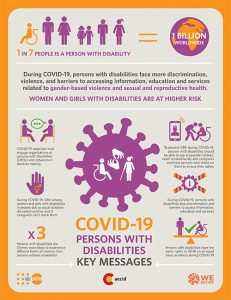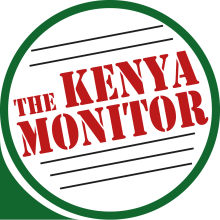Covid -19 has really affected people in a hard way and among the badly hit are women and girls with disabilities who have struggled to meet their basic needs, access needed health services including those needed both because of their gender and disability, and have faced disproportionate risks of violence.
This is according to a global study commissioned by the U.N. Population Fund (UNFPA) and Women Enabled International (WEI), alongside the U.N Partnership for the Rights of Persons with Disabilities and eight local and regional organisations working to advance rights for persons with disabilities.
“When I worked in the disability [sector] in 1993, women with disabilities’ situation was worse, because they had to live inside the house. They had nothing to do. They were uneducated. … With the pandemic, that same situation is happening to women with disabilities again, because they are losing their jobs, they have to stay all day and night with the family and can’t contribute to the family. It is a really hard time, especially for women with disabilities.” — Rama, a woman with a physical disability, Nepal
“Through virtual consultations with and written survey responses from over 300 women, girls, men, and gender non-conforming persons with disabilities, their advocates, and their support persons from around the world, we have learned that in almost all contexts—Global North and Global South, in places hit hard by COVID-19 and others with a much lower rate of infection—women, and girls with disabilities have been left behind,” read part of the report
For instance, some women and girls with disabilities who require the assistance of sign language interpreters or other assistants to access SRH services were no longer allowed to bring those individuals with them, due to social distancing rules.
Lack of accessible and affordable transportation options meant that, when family planning clinics closed in local communities, women and girls with disabilities disproportionately could not travel to other communities to receive SRH services and goods.
In two extreme cases, a deaf woman from Fiji and a non-binary autistic person from Chile could not access urgent SRH services and faced potentially dire consequences for their health and lives.
“The study which revolved around the impact of COVID19 on women and girls with disabilities, particularly as related to their sexual and reproductive health and rights (SRHR) and their right to be free from gender-based violence (GBV), identifies that: Barriers to accessing sexual and reproductive health (SRH) information, goods, and services and exercising bodily autonomy for women and girls with disabilities have increased during the COVID-19 pandemic, in ways that are both similar to and distinct from other women’s experiences,” read a part of the report.
Additionally, women and girls with disabilities worldwide faced increased risk factors for GBV and compounded barriers to accessing GBV support services, police, and justice mechanisms. As women and girls with disabilities were confined at home with their families and lost their usual systems of support, tensions rose, leading to physical, sexual, emotional, and psychological violence against them.
Family and friends who were new to caretaking responsibilities, or who were not receiving respite from those responsibilities, sometimes withheld needed assistance or weaponized disability to denigrate or undermine women and girls with disabilities.
At the same time, GBV support services became even harder to access due to lockdown measures, and police were re-allocated away from investigating GBV and towards enforcing COVID19 restrictions. Justice mechanisms also moved even more slowly in some contexts, leading to virtual impunity for perpetrators.
Women and girls with disabilities—often primarily due to their disability status—were cut off from other needed health services and lost access to employment as well as education.

Additionally, they lost access to disability-related support services and faced significant barriers to affording and accessing food, clean water, housing, sanitation items, and other basic needs. These other related rights issues impacted the ability of women and girls with disabilities to fully exercise their SRHR, bodily autonomy, and the right to be free from violence.
Gender and disability have not necessarily equally impacted the experiences of women and girls with disabilities during the COVID-19 pandemic. For instance, the barriers that women and girls with disabilities report to meeting basic needs or to accessing employment and education during the COVID-19 pandemic are largely based in disability discrimination and exclusion.
On the other hand, many of the new barriers they have experienced to accessing SRH and exercising bodily autonomy are similar to those experienced by other women and girls. However, the situation of women and girls with disabilities before this crisis was significantly worse than for others.
Before the pandemic, they were less likely than both men and boys with disabilities and non-disabled women to have access to employment or education; were more likely to live in poverty; faced higher rates of violence, and encountered significant accessibility and attitudinal barriers based on both gender and disability to exercising their SRHR.
These pre-existing barriers, combined with the impact of COVID19 itself, have created a particularly precarious situation for women and girls with disabilities, as distinct from other groups.
In addition to these global findings, this Impact Assessment presents four case studies on the impact of COVID19 in particular country contexts. These countries—Malawi, the United Kingdom, Chile, and Fiji—were in very different places in ensuring the rights of women and girls with disabilities before the COVID-19 pandemic, had different experiences with the severity of the pandemic, and had different governmental and public health responses.
These case studies provide the opportunity to examine how differences in the realization of rights for women and girls with disabilities before the pandemic, as well as differing approaches to the crisis, have impacted women and girls with disabilities from a variety of backgrounds.
With the results of the study, the onus is now on the United Nations Country Teams, civil society, governments, multilateral organizations, and others involved in COVID-19 response and recovery—as well as planning, response, and recovery from other crises—to ensure that their policies and practices are inclusive of women and girls with disabilities and their rights are promoted.
This resource pack consists of a Compendium of good practices, SRHR checklist, and Impact Assessment and focuses on three objectives:
- Ensuring gender- and disability-inclusive SRH during the COVID-19 pandemic
- Meeting social determinants of health for women and girls with disabilities during the COVID-19 pandemic
- Ensuring long-term SRHR for women and girls with disabilities in the recovery from COVID-19 and beyond


